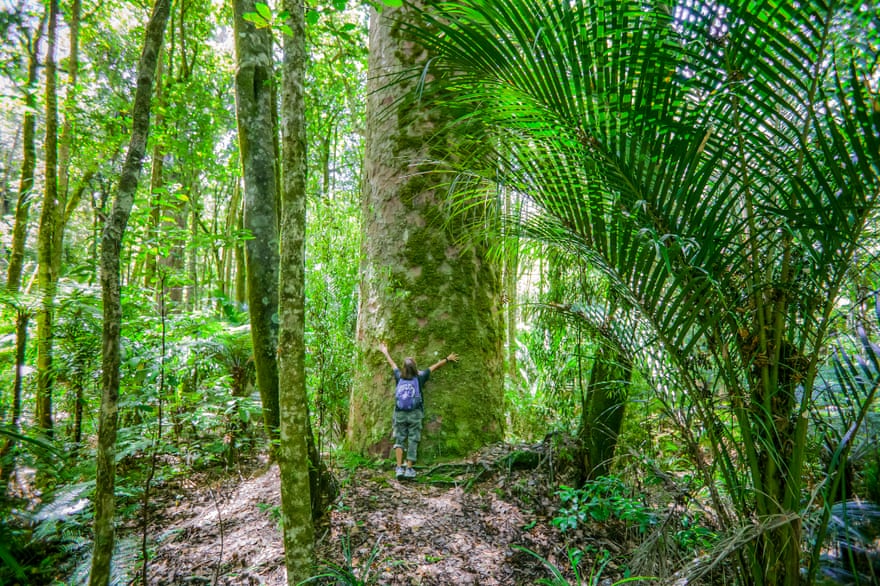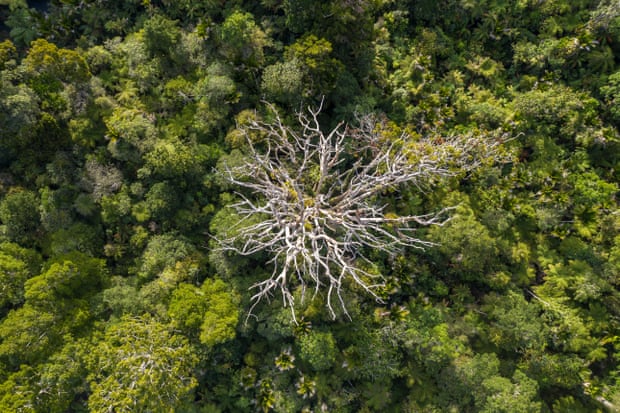Look out at the forest of Waitakere and you will see the skeleton of Aunt Agatha above the treeline. The tree – who gained her nickname from generations of schoolchildren – was still alive and topped with a proud plume of foliage just a few years ago. Now the trunk stands white as an exposed bone, huge ribbons of bark sloughed off on the ground like recently shed skin.
Ranger Stuart Leighton walks down an empty track toward her, stepping on to the large, freshly completed wooden deck. It’s kind of unusual, he says, to build a viewing platform for a dead tree. “We wanted to make a point: this isn’t some made-up thing, or something that’s not serious or something on a tiny little scale that we’re overcooking. This is a very real thing that’s happening to our forest.”
This park is the frontline of the battle to save kauri (Agathis australis) – Aotearoa’s largest, most sacred trees. Aunt Agatha is estimated to be more than 1,000 years old, and has stood over this valley since before humans arrived on New Zealand’s shores. She survived colonial arrivals and the voracious appetite for timber, outlasting the transformation of Auckland from scrappy settlement to city of 1.57 million.

Kauri can live for more than 2,000 years, growing to more than 50 metres tall, so she may have only been in middle age when she died. The foe that ultimately took her down was a microscopic pathogen in soil, spread unwittingly on animal tracks and the soles of hikers’ shoes. It is almost always fatal for infected Kauri – especially those already under pressure from the encroachment of human activity, changing weather patterns and a heating climate.
Now, the tracks that wind through the forest around Agatha – once visited by about 800,000 people a year – are silent. Most have been closed off to the public for almost five years now, in a radical effort to buy time and breathing room to protect the trees that are still healthy. Today, conservationists say there are some glimmers of hope for New Zealand’s kauri – and the most optimistic strategies reflect a gradual transformation of how New Zealand approaches conservation, with Māori knowledge on the frontlines.
‘That tree has watched over generations’
Five years ago, Edward Ashby was there as his iwi [tribe], Te Kawerau ā Maki, stood in front of Aunt Agatha and laid a rāhui: a cultural ban on human entry, placed to protect tapu [sacred] or ecologically fragile places. Back then, he says, “she still had the crown of leaves”. He likens her death to the loss of an ancestor.
“That tree has watched over entire generations of Kawerau people, and even the ancestors before … right back to human origins in this country,” says Ashby, who is the tribe’s conservation lead. “It’s watched us as a people grow up, right from when the first waka arrived.”
The initial government response to Kauri dieback, after the pathogen was identified in 2008, was criticised as piecemeal and insufficient, with some scientists predicting the trees would be extinct within a few decades.
Without centralised government action, often it was iwi [Māori tribes] that stepped into the gap, creating protections for the trees to try to buy scientists more time. Rāhui became one of the central tools used to keep fragile regions safe. In Northland, Te Roroa created kauri ambassadors to protect Tane Mahuta – New Zealand’s most famous kauri.

When the government finally created a national kauri preservation plan – released this month – the biosecurity minister, Damien O’Connor, said it would be Maori-led.
“Māori will be supported to lead kauri protection and funding will be provided to build capacity in iwi, hapū and whānau to deliver operationally,” he said.
But rangers and some scientists say the battle has also contributed to a deeper and more widespread transformation of conservation work in New Zealand, which increasingly looks to matauranga – Māori knowledge systems – to reinforce and inform scientific approaches.
In consultation with Te Kawerau ā Maki, the rangers have begun an intricate process of re-engineering tracks through the reserve – suspending many of them above the ground, and avoiding deep foundation pillars that disrupt root systems.
The increasingly close weaving of matauranga and science in New Zealand has, at times, been controversial – last year, Richard Dawkins weighed in, writing to the New Zealand Royal Society to say that “no indigenous myths from anywhere in the world, no matter how poetic or hauntingly beautiful, belong in science classes”.
‘We’ve got all of these impacts colliding’
In the case of kauri, however, rangers and conservationists say the advice of Māori has shaped and often predicted the scientific advice, as conservation efforts shift from a focus on kauri alone to a more holistic, interconnected one that looks at pressures on the forest as a whole.
“We’re not just talking about a relationship between the pathogen and its host,” says kauri dieback biosecurity specialist Lisa Tolich. “The [wider] environment does play a big part in this – basically if you have environmental conditions that tip the scales in favour of the pathogen … as soon as the tree is stressed, it is more susceptible.”

Leighton likens the disease’s spread to the children’s game kerplunk, where a crisscross of sticks suspends a mass of marbles.
“Since people have arrived, we’ve been pulling the sticks out,” he says. “We’ve got all of these impacts colliding. It’s climate change, this newly discovered pathogen, the impacts of lots of footfalls … introduced species – all creating this enormous pressure. When you start to do that to an ecosystem, you start to see things falling over … eventually, the marbles will start to drop through.”
The key to solving dieback may not be a single vaccine or cure, he says, but the more complex, long-term task of restoring forests to health, and trying to minimise the impact of human presence.
“I think we’ll look back at this point in time, and we’re starting to see, nationally, a change in how we approach some of our natural resources,” he says. “The western science, if you like, it’s starting to point more and more to that interconnectedness.”
Soon, the tracks of the Waitakere forest will start to reopen, with constant monitoring of kauri to see if the trees are being jeopardised by people’s return. But their closure, too, has forced a shift in the way Aucklanders approach the forest the flanks the city.
“For me, this is all comes down to people needing to examine quite carefully their relationship with nature, and I think reconsider the extractive attitude we have,” Ashby says. “That nature is just this infinite thing that we should go and extract an experience or a resource out of.
“Actually [we] need to start thinking of it like a mother or a family member. We need to invest in it and look after it.”
Salvation of New Zealand’s dying giant kauri trees may have roots in Māori wisdom | New Zealand & Latest News Update
Salvation of New Zealand’s dying giant kauri trees may have roots in Māori wisdom | New Zealand & More Live News
All this news that I have made and shared for you people, you will like it very much and in it we keep bringing topics for you people like every time so that you keep getting news information like trending topics and you It is our goal to be able to get
all kinds of news without going through us so that we can reach you the latest and best news for free so that you can move ahead further by getting the information of that news together with you. Later on, we will continue
to give information about more today world news update types of latest news through posts on our website so that you always keep moving forward in that news and whatever kind of information will be there, it will definitely be conveyed to you people.
Salvation of New Zealand’s dying giant kauri trees may have roots in Māori wisdom | New Zealand & More News Today
All this news that I have brought up to you or will be the most different and best news that you people are not going to get anywhere, along with the information Trending News, Breaking News, Health News, Science News, Sports News, Entertainment News, Technology News, Business News, World News of this made available to all of you so that you are always connected with the news, stay ahead in the matter and keep getting today news all types of news for free till today so that you can get the news by getting it. Always take two steps forward
Credit Goes To News Website – This Original Content Owner News Website . This Is Not My Content So If You Want To Read Original Content You Can Follow Below Links
